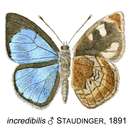Comprehensive Description
provided by Memoirs of the American Entomological Society
Iridana incredibilis Staudinger
Iris incredibilis Staudinger, 1891: 141; pi. 1, fig. 7. Iridana incredibilis: Stempffer and Bennett, 1956: 507.
The species ranges from Sierra Leone through Nigeria to Uganda. Liberia: Kpain, VIII (Stempffer and Bennett, 1956). Distinguished by the following combination of characters: origin of stalked R> -, of forewing distinctly separated from origin of Mi by at least as great a space as between it and origin of R^.; all five radials present; males with androconial patch often associated with vein 2A of forewing; coremata present in males, prominent (when exserted), the investing scales smaller than in the Iridanini and nearly black; falces present; valva distally with only one lobe; penis straight or slightly arcuate, stout, simple.
The male genital structures are quite uniform throughout the group, offering little help in the determination of relationships among the genera. The early stages, however, hold some promise in this connection (see Aurivillius, 1923: 1198-1199).
The Epitolini are stout-bodied insects, with ample, strong wings; they are almost universally blue above, at least in the males, and their pattern below is often very un-lycaenoid, recalling certain nymphalids in a general way. None of the species can be considered very common in collections and many are exceedingly rare. They appear to be confined to the great West African rain forest, occurring from Sierra Leone eastward to Uganda, and south to northern Angola.
The genus Deloneura Trimen ( extralimital ) quite probably belongs here (see remarks in subfamily discussion of Liphyrinae below), though it embodies exceptions to several of the statements above: it
lacks one radial vein; both sexes are predominantly orange or ochreous; and it occurs in southern and eastern Africa.
- bibliographic citation
- Fox, R.M., Lindsey, A.W., Clench, H.K., Miller, L.D. 1965. The Butterflies of Liberia. Memoirs of the American Entomological Society vol. 19. Philadelphia, USA
Iridana incredibilis: Brief Summary
provided by wikipedia EN
Iridana incredibilis, the incredible sapphire gem, is a butterfly in the family Lycaenidae. It is found in Sierra Leone, Liberia, Ivory Coast, Ghana, southern Nigeria, Cameroon, the Democratic Republic of the Congo and Uganda. The habitat consists of forests.
Adults are on wing in September, November and January.
The larval host plant is unknown, but both larvae and pupae were found on the bark of Alstonia congensis. They live on the bark in the company of ants of the genus Crematogaster. The larvae spin a silk shelter for themselves over a crack in the bark. Pupal cases have also been found on Albizia lebbeck.
- license
- cc-by-sa-3.0
- copyright
- Wikipedia authors and editors

